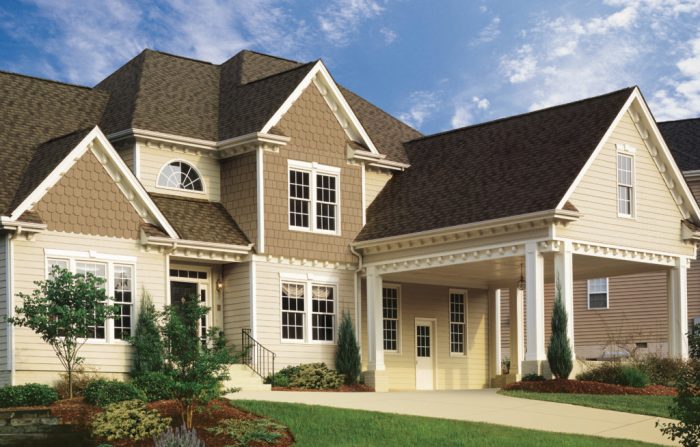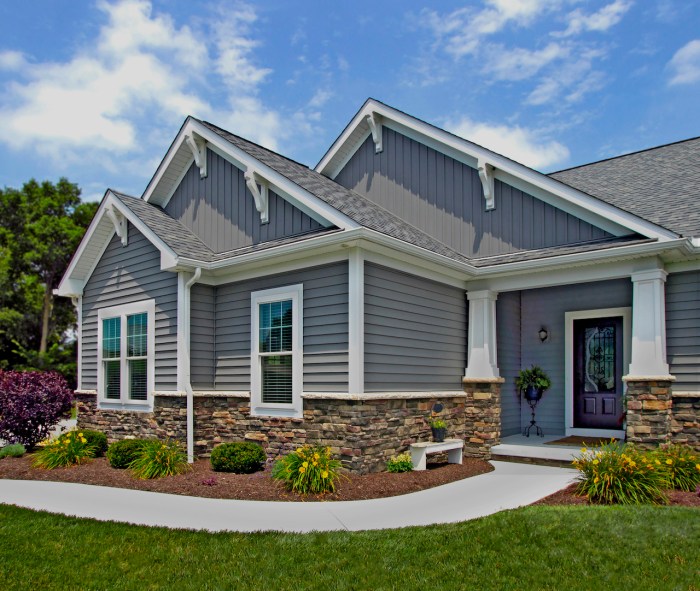Elevate Your Home with Inspiring Exterior Siding and Roofing Ideas
Step into the world of home exterior design with a focus on siding and roofing ideas. From classic to contemporary, the possibilities are endless as we delve into the realm of enhancing your home's facade.
Delve into the characteristics, pros, and cons of various siding materials and roofing options to find the perfect fit for your home.
Types of Siding Materials

When it comes to choosing the right siding material for your home exterior, there are several options available. Each type of material has its own unique characteristics, pros, and cons that should be considered before making a decision.
Vinyl Siding
Vinyl siding is one of the most popular choices for homeowners due to its affordability and low maintenance requirements. It is available in a wide range of colors and styles, making it easy to find a look that fits your home's aesthetic.
However, vinyl siding can be prone to cracking and fading over time, and may not be as durable as other materials.
Wood Siding
Wood siding offers a classic and natural look that can enhance the charm of a home. It is also relatively easy to repair and replace individual boards if needed. However, wood siding requires regular maintenance, including painting or staining to protect it from the elements.
It is also susceptible to rot, pests, and fire, which can be drawbacks for some homeowners.
Fiber Cement Siding
Fiber cement siding is a durable and low-maintenance option that can mimic the look of wood or masonry. It is resistant to rot, pests, and fire, making it a popular choice for many homeowners. However, fiber cement siding can be more expensive upfront compared to other materials, and installation may require professional help due to its weight.
Metal Siding
Metal siding, such as steel or aluminum, offers a modern and sleek appearance that can add a contemporary touch to a home. It is highly durable and resistant to fire, rot, and pests. However, metal siding can be prone to dents and scratches, especially in areas prone to severe weather conditions.
Additionally, metal siding may be more expensive than other materials and may require insulation to prevent heat loss.
Roofing Options for Homes
When it comes to roofing options for homes, there are several materials to choose from, each with its own set of benefits and considerations. From the traditional asphalt shingles to more modern options like metal, clay tiles, and slate, homeowners have a variety of choices to suit their needs and preferences.
Asphalt Shingles
Asphalt shingles are one of the most popular roofing materials due to their affordability and ease of installation. They come in a wide range of colors and styles, making them a versatile option for many different home designs. However, asphalt shingles may require more frequent maintenance and have a shorter lifespan compared to other materials.
Metal Roofing
Metal roofing is known for its durability and longevity, often lasting 50 years or more. It is also fire-resistant and energy-efficient, reflecting heat and reducing cooling costs in the summer. While metal roofing can be more expensive upfront, the long-term savings and minimal maintenance requirements make it a popular choice for many homeowners.
Clay Tiles
Clay tiles are a classic choice for roofing, offering a timeless and elegant look to any home. They are extremely durable and can last for over 100 years with proper maintenance. However, clay tiles are heavier than other materials, requiring a reinforced roof structure for support.
They are also more expensive than asphalt shingles or metal roofing.
Slate Roofing
Slate roofing is known for its natural beauty and exceptional durability, with some roofs lasting over 100 years. It is resistant to fire, mold, and mildew, making it a low-maintenance option for homeowners. While slate roofing is one of the most expensive materials upfront, its longevity and aesthetic appeal make it a worthwhile investment for many.
Color and Design Trends
When it comes to home exterior colors and designs, staying up-to-date with the latest trends can greatly enhance the overall appeal of your property. From siding to roofing, the color and design choices you make can significantly impact the curb appeal and resale value of your home.
Popular Color Schemes and Styles
- Neutral Tones: Shades of gray, beige, and white continue to be popular choices for modern homes. These colors provide a timeless and elegant look that appeals to a wide range of tastes.
- Dark Accents: Adding dark accents such as navy blue, forest green, or charcoal can create a striking contrast and add depth to the exterior of your home.
- Earth Tones: Colors inspired by nature, like terracotta, olive green, and warm browns, are gaining popularity for their calming and inviting appeal.
Impact on Curb Appeal and Resale Value
Your choice of colors can significantly impact the curb appeal of your home. A well-chosen color scheme can make your property stand out in the neighborhood and attract potential buyers if you ever decide to sell. Bright and bold colors may appeal to some, but it's essential to consider the overall aesthetic of your home and the surrounding environment to ensure a cohesive look that enhances the value of your property.
Sustainable and Eco-Friendly Solutions

As more homeowners prioritize sustainability and environmental consciousness, choosing eco-friendly siding and roofing options has become increasingly popular. These solutions not only benefit the environment but also contribute to creating a healthier living space.
Recycled Wood Siding
One sustainable option for siding is using recycled wood materials. This type of siding is made from reclaimed wood, which helps reduce waste and minimizes the need for cutting down new trees. It provides a unique, rustic look while promoting eco-friendly practices.
Solar Reflective Shingles
Solar reflective shingles are another eco-friendly roofing option that can help lower energy costs. These shingles are designed to reflect sunlight and reduce heat absorption, keeping the home cooler during hot weather. By decreasing the need for air conditioning, solar reflective shingles can contribute to energy efficiency.
Green Roofs
Green roofs involve planting vegetation on the roof of a building, providing numerous environmental benefits. They help reduce stormwater runoff, improve air quality, and enhance insulation, leading to energy savings. Green roofs also create habitats for wildlife and contribute to urban biodiversity.
Creating an Energy-Efficient Home Exterior
Implementing green building practices can significantly improve the energy efficiency of your home's exterior. Consider adding extra insulation, installing energy-efficient windows and doors, and sealing any air leaks to minimize heat loss. Combining sustainable siding and roofing materials with energy-saving strategies can create a more environmentally friendly and cost-effective living space.
Wrap-Up
Wrap up your journey through home exterior design with a recap of the key points discussed, leaving you inspired to transform your home with newfound knowledge and creativity.
FAQ Summary
What are some eco-friendly siding options?
Consider materials like recycled wood or fiber cement that offer sustainability and style.
Which roofing material is best for energy efficiency?
Metal roofs are known for their energy-saving properties and longevity.
How can color choices impact curb appeal?
The right color scheme can enhance your home's exterior and boost its resale value.




